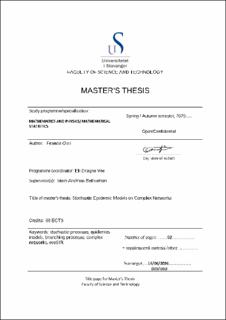| dc.contributor.author | Osei, Francis | |
| dc.coverage.spatial | | en_US |
| dc.date.accessioned | 2020-09-29T09:19:46Z | |
| dc.date.available | 2020-09-29T09:19:46Z | |
| dc.date.issued | 2020-06-14 | |
| dc.identifier.uri | https://hdl.handle.net/11250/2680207 | |
| dc.description | Master's thesis in Mathematics and Physics | en_US |
| dc.description.abstract | The spread of a virus or the outbreak of an epidemic are natural examples of stochastic processes. Classical mathematical descriptions of such phenomenon include various branching processes such as the SIR (Susceptible-Infected-Recovered) model and the SIS (Susceptible-Infected-Susceptible) model. The basis of this thesis consists of giving a comprehensive overview of the mathematical theory behind these models with an emphasis on the SIR model and its evolution on complex networks. Further, following [1],[2],[3], we consider the evoSIR on three network structures (Erdös Rényi Graph (ER graph), Configuration model network and the preferential attachment model) in which a susceptible after learning the status of his neighbor breaks that connection at rate ρ and rewire to a randomly chosen individual in the population. We show through simulations that, delSIR can reduce the final size of an outbreak of diseases with a higher probability. Finally, we show that the network structure crucially influences the measures to control the outbreak of diseases at the population level. | en_US |
| dc.language.iso | eng | en_US |
| dc.publisher | University of Stavanger, Norway | en_US |
| dc.relation.ispartofseries | Masteroppgave/UIS-HF-IMF/2019; | |
| dc.title | Stochastic Epidemic Models on Complex Network | en_US |
| dc.type | Master thesis | en_US |
| dc.description.version | submittedVersion | en_US |
| dc.subject.nsi | VDP::Matematikk og Naturvitenskap: 400 | |
